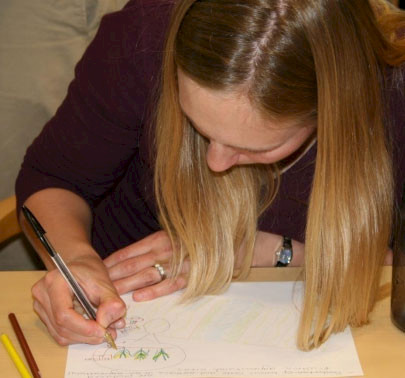Conceptionary in action: Learning through play
Bill Dennison ·One of our favorite teaching modules is about conceptual diagrams, and the activity associated with this module is called Conceptionary. It is a game in which teams of 4-10 people are formed and one team member is designated as the 'science illustrator'. The 'science illustrator' is given a card with an environmental concept explained and several key words are identified. The team then attempts to guess the key words as the 'science illustrator' depicts the environmental issue using colored pencils and blank paper within a couple of minutes, and without speaking. This activity is similar to the popular board game 'Pictionary', in which players guess words that one player draws. 'Conceptionary' uses concepts, not just words, in which a series of interlinked activities or processes are developed through a drawing. In addition, colors are used and abstract concepts are developed in conceptionary. Conceptionary is always very popular with the various different groups we are working with, and we have begun to realize why the half hour or so that we take to play Conceptionary is so effective.

The major learning objectives that we established for Conceptionary were the following:
- Players realize that complex concepts can be effectively communicated with rudimentary tools (colored pencils and paper) within a few minutes.
- Players appreciate that artistic talent is not needed to be an effective communicator. Some of the most effective drawings are not artistic, but creative linkages and good caricatures are developed.
- Effective use of colors can highlight important features, by providing realism or by drawing attention to key processes.

These learning objectives provide a foundation for developing the ability to create conceptual diagrams, which is the learning objective for the teaching module. But when we began to ask the students what they learned from this activity, we learned that they were getting a lot more out of the activity than we realized. Some of the feedback we got was the following: Drawing is fun! For many people, it had been years or decades since they made colored drawings and it reminded them of how much fun creating a drawing can be. There are a diversity of approaches to communicating a specific concept, and many different ways can be used to effectively communicate--there is not a 'best' approach. Keeping the drawing relatively simple, with a focus on the key concept being depicted, helps guide the audience to the message. There are some iconic universal symbols that are useful in developing conceptual diagrams. These symbols are the building blocks of diagrams. Diagrams that integrate maps can be helpful, as geographic features are often an essential element of the concept. Drawings are not only worth many words, but also are a fast way to get a message across. Like the classic style of teaching using a blackboard, talking while drawing can be quite effective, so adding illustrations can greatly augment a story. Finally, the team building aspect of working together in groups can be important, particularly with groups of people who do not normally work together. This feedback was really amazing, and it confirmed the positive reaction we had gotten from Conceptionary participants. We had often debated about whether or not we could afford the time to play Conceptionary or that we would have a receptive group, but we have never regretted our Conceptionary activity. Reflecting on the variety of groups that have played Conceptionary, it is apparent that drawing taps into a very basic human experience. We have played Conceptionary with junior and senior scientists, undergraduates and graduate students, resource managers in Washington D.C. and fishermen in Palau, non English speakers and non scientists.
About the author
Bill Dennison

Dr. Bill Dennison is a Professor of Marine Science and Vice President for Science Application at the University of Maryland Center for Environmental Science.

